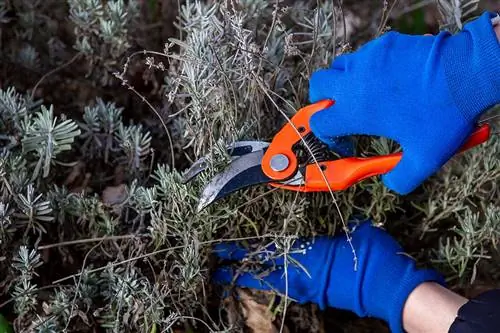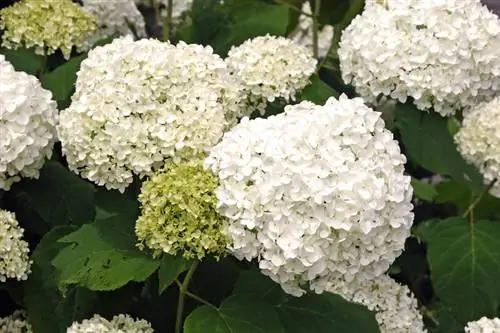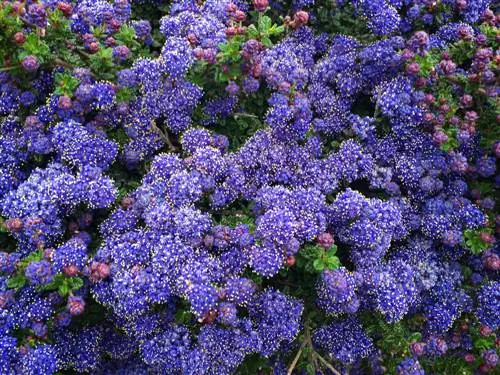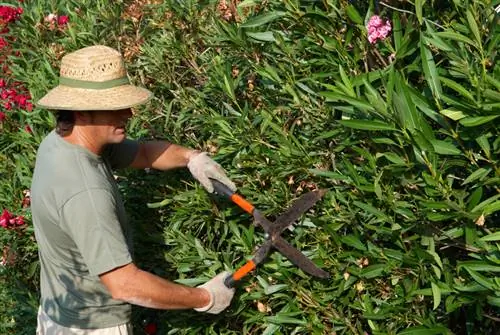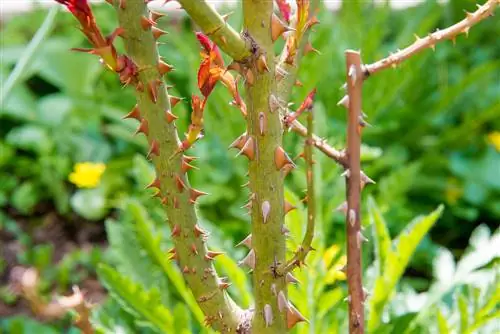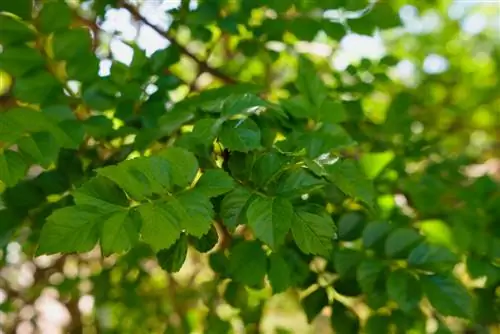- Author admin [email protected].
- Public 2024-01-05 20:48.
- Last modified 2025-01-23 11:21.
To prevent lavender from aging, it should be cut regularly in spring. With a little practice, this gardening task can be carried out quickly and easily. Even if no pruning has been done for a long time, you can use two radical pruning methods to try to save the dead lavender before you dig it up and replace it with a new one.

When should you cut lavender?
Lavender should be cut in spring between mid-February and mid-March to encourage balding and a compact growth habit. In summer, an intermediate cut can be made between the end of July and the end of August to achieve a second flowering period.
When should lavender be cut?
The ideal time for pruning isearly spring between mid-February and mid-March As a rule, annual budding begins at the end of March at the latest, so pruning should be done beforehand. If you prune later, there is a risk that the flower will fail due to cutting off the new shoots.
Intermediate cutting can be done in summer between the end of July and the end of August. The old inflorescences are removed in order to achieve a second flowering period in late summer.
In order to enable optimal wound closure, attention should be paid to the following weather conditions:
- no (permanent) frost
- no rain
- no wind
- no direct sunlight
- best case: overcast weather with a temperature between 8 and 15 degrees Celsius
True lavender should be pruned at least once a year. You can find out here how you can tell whether your lavender is the real plant from the Mediterranean region. This promotes a compact growth habit and helps maintain it. In addition, regular shortening of the shoots promotes lush flowering.
How to cut lavender?
In addition to the right time, there are other factors to consider for optimal pruning of lavender. In addition to the scope of the cutting measures, this also includes the correct cutting technique. Every single criterion is essential for the best possible development of the shrub.
How far should lavender be cut back?
The extent of the pruning is directly related to the cutting date. While the first pruning of the year is very extensive, the second is much more moderate. Pruning in early spring essentially serves to restore a dense structure. To do this, the individual shoots are shortened to a maximum of the first pair of leaves above the woody area. The individual branches should be trimmed on average by around2/3 of their length. Further pruning should only be done carefully, as the lavender has difficulty sprouting from the woody parts.
Only the flower stalks should be removed during the second pruning. The intersection point should therefore be just above the top pair of leaves. Usually the cut shoot length is about1/3 of the original length.
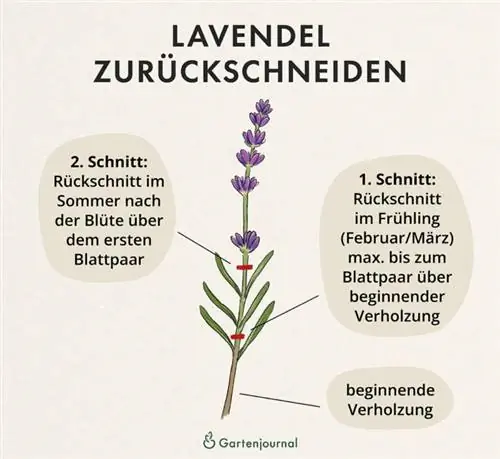
The right cutting technique
Due to the often small diameter of the shoots, a smallhedge or garden shear is completely sufficient for pruning. In order to avoid the spread of diseases and to set the interfaces straight, it is recommended to prepare the tools accordingly in advance. For this purpose, the cut surfaces should be sharpened and disinfected.
The use of electrical devices should be avoided. The constant movement of the blade promotes fraying of the wound areas. This in turn causes impaired wound healing, which makes penetration of pathogens more likely.
For a subsequent even cut, all branches should be combined into a bunch. Depending on the size of the perennial, this can be done either with one hand or with a band. The subsequent cut starts below the hand or the band. Finally, selected shoots can be trimmed if they have not yet been shortened sufficiently.
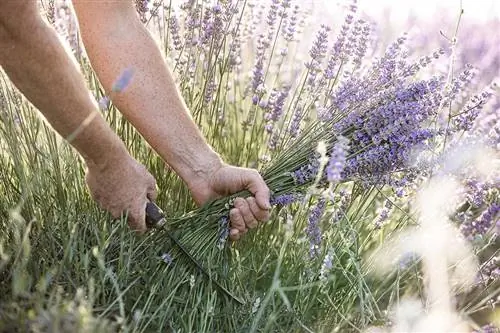
For an even pruning, it is recommended to gather the branches into a clump and then separate them in bundles.
Is it important to remove old inflorescences?
Botanically, lavendula is classified as a subshrub that tends to lose its lower shoots over time. Therefore, especially with this type of plants, it isessential to prune the branches annually. This stimulates new growth and prevents the formation of woody sections. If pruning is not done, the extent of woodiness continues to increase. Over several years, fewer and fewer new leaves and flowers are formed.
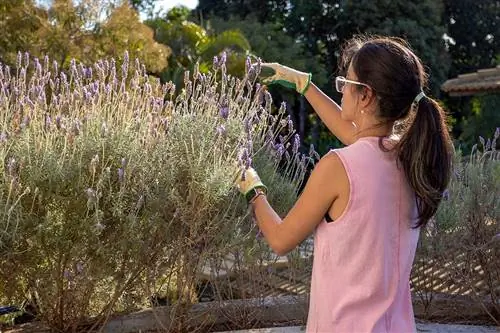
Without continuous pruning, Lavendula begins to grow bald from the bottom up. In addition, the formation of new shoots and flowers continues to decline.
Instructions: Cutting lavender
Both pruning in spring and intermediate pruning in summer are essential for even growth of lavender. In addition, the natural hemispherical shape is maintained through constant trimming. The following are comprehensive instructions on how to carry out the individual cutting measures.
Pruning in spring
Time
early spring between February and March, no more sub-zero temperatures
Instructions
- If necessary, tie the bush into a bun with a ribbon
- Cut back shoots by at least 10 to 15 centimeters
- maximum pruning of around 2/3 of the total length, at least one pair of leaves should remain
- leave out bare areas from trimming
- ideally cut back in the shape of a hemisphere for dense and compact growth, if necessary the use of a template is also useful
- Repeat cutting measures annually to prevent excessive baldness
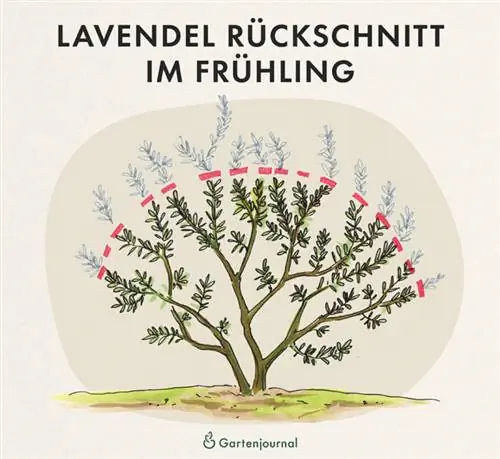

Intermediate cut in summer
Time
Summer between mid-July and mid-August, shoot tips should already be withered
Instructions
- Tie up the perennial to make cutting easier
- shorten individual branches by at least 5 centimeters
- better still, remove the faded areas completely down to the top pair of leaves
- cut back by a maximum of 1/3 of the total length
- Restore hemispherical shape through the intermediate cut
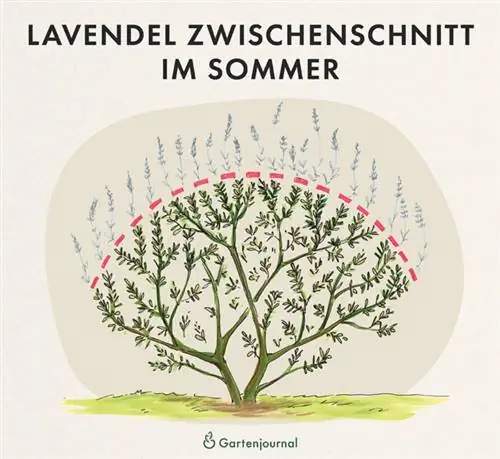
What happens if you miss the second pruning?
Basically, this hasnone negative effects on the plant itself, because pruning in spring is sufficient. The second pruning only serves to produce new flowers in the same year. You can also skip this cut. Balding of the shoots is more likely to occur if the main cut is not made in spring.
Under no circumstances should the intermediate cut be made up at a later date. The interfaces are extremely susceptible to frost damage over several weeks. In the worst case, a delayed pruning will result in the entire plant dying due to irreparable damage.
Pruning old lavender
Old lavender can also be pruned. However, the chances of success for new growth decrease with the extent of the baldness. This is primarily due to the nature of the subshrub, which only produces fragrant flowers on new shoots. In addition to patience, a bit of luck is also required for a successful restart.
Lavender rejuvenate
Rejuvenation of your lavender bush is particularly necessary if it has not been cut for several years. Due to increasing aging, fewer and fewer new shoots are forming, so flower formation is also severely inhibited. In addition, these plants are characterized by their very spreading growth.
Time
between June and July, budding should have already started
Instructions
- group individual leaves together
- shorten leafy bushes by half each time
- remove additional dead areas with old leaves
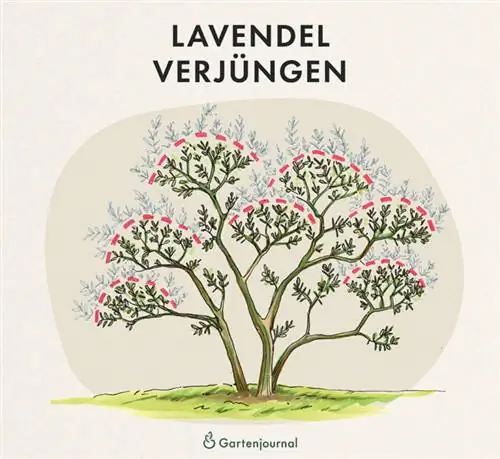
Pruning the new shoots creates a sap buildup in the plant. In the best case scenario, this is used to grow young shoots on old wood. However, as mentioned before, there is some risk associated with this cutting technique. There is no guarantee of success with lavendula that is already very old.
Prune lavender radically
The success of a radical pruning is just as dependent on luck as the aforementioned rejuvenation. However, the risk is significantly increased with this cut variant because it is significantly more extensive. Additional fertilization of lavender with an extensive combination of nutrients provides the plant with ideal support. Lavender prefers nutrient-poor soils and is extremely undemanding overall. Additional information on species-appropriate fertilization can be found here.
Basically, two different approaches can be distinguished, which are supposed to produce the same effect. Namely the basic new growth of an already heavily woody perennial.
Variant 1
The first variant follows the same train of thought as the taper described previously. By radically pruning during budding, the subshrub should be forced to sprout new growth on the old branches using the plant sap it contains.
- tie the entire plant with a ribbon
- Cut lavender radically down to the lowest pair of buds (maximum height of 10 to 15 centimeters)
- for particularly sprawling bushes: carry out pruning in stages, but necessarily on the same day

Variant 2
In comparison, the second method takes a different approach. The focus here is on converting the woody areas. By pruning and further processing the plants, they should serve as a basis for stable growth in the future and develop their own roots. It is also recommended that this measure be implemented at the beginning of budding in order to increase the chances of success.
- cover shoots close to the ground, lying almost horizontally, with a mixture of sand and soil
- Pile the earth up to the lowest pair of buds if possible and press it firmly
- Prune branches with new shoot tips as with regular spring pruning
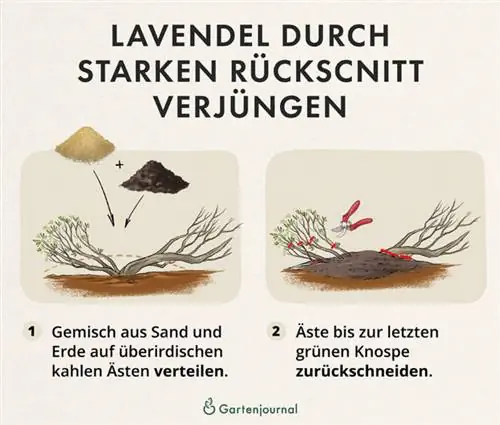
Cutting lavender in the pot
Lavender bushes that are grown in pots require just as extensive care in terms of pruning as their relatives planted outdoors. However, due to the limited filling volume in the bucket, the specimens generally grow a little slower and expand less in width. The pruning can therefore be slightly less if necessary, but should not be completely suspended. You can find further care tips for potted lavender in this article.
The optimal times for pruning in spring and summer do not differ. Ideally, the more extensive pruning takes place between February and March, the intermediate pruning in the summer should take place between July and August.
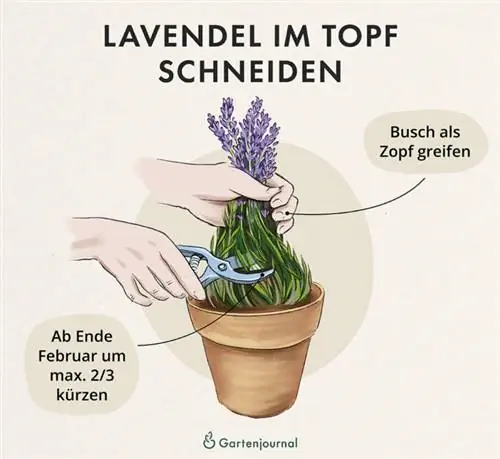
Spring pruning instructions:
- Gathering branches together
- Cut shoots back to a maximum of the lowest pair of leaves, but at least by 10 to 15 centimeters
- additional shortening of individual branches to maintain an even shape
Summer cutting instructions:
- Gather the stems together with your hand
- Short the branches no more than to the top pair of leaves, but at least by 5 centimeters
- If necessary, additionally prune selected shoots more heavily or weakly
In any case, make sure not to cut into the woody areas. The potted plants also respond to a too radical cut, in the worst case scenario with a complete lack of new leaves and lavender flowers.
Cutting the lavender tree
Pruning a lavender tree is basically done using the same procedures as a shrub. Therefore, extensive pruning in spring and intermediate pruning in summer are also necessary.
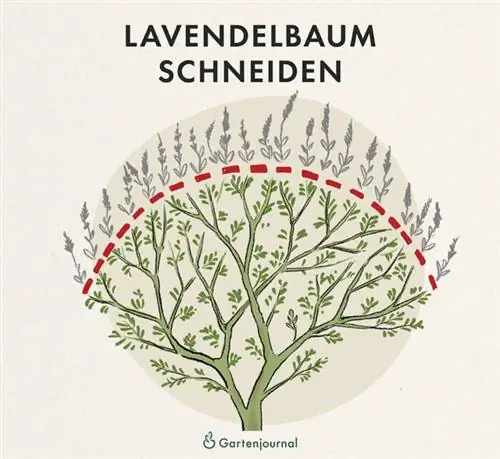
Spring pruning instructions:
- Wait between February and March without frost
- Pruning the crown shoots by a maximum of 2/3 of the total length
- Producing a uniform hemispherical shape
Summer cutting instructions:
- Check the time between mid-July and mid-August and the flowers have completely dried out
- Pruning the crown shoots by a maximum of 1/3 of the total length
In addition, you should regularly remove new shoots from the trunk. However, with increasing age and degree of woodiness, shoot formation should decrease.
Forgot to cut lavender: what to do?
In principle, skipping one pruning per year is not a concern. However, skipping both dates or incomplete pruning for several years should be avoided if possible.
Both the spring cut and the summer cut shouldnotbe made up at a later date. Late spring pruning usually results in a loss of flowering because the new shoots are completely shortened. A delayed summer cut, for example in October, can lead to the plant dying due to irreparable frost damage. By thenext pruning in spring at the latest, previous cutting dates that have failed can usually be corrected without any problems.
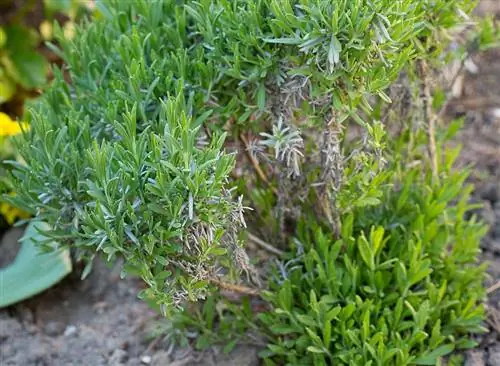
Stopping pruning once is generally not a problem with lavender. However, you should maintain a regular pruning routine to maintain a he althy shrub.
FAQ
How is the woodiness of lavender counteracted?
The woodiness can only be stopped by regular pruning. This stimulates the formation of new shoots through increased sap production.
How far should lavender be cut back?
For more extensive spring pruning, lavendula is cut back by at least 10 to 15 centimeters, but by a maximum of 2/3 of the total length. However, at least one pair of leaves should remain on each shoot. In comparison, the summer average is significantly more moderate. Only the dried shoot tips are removed. In practice, a length of 5 centimeters or a maximum of 1/3 of the total length has proven to be effective. However, you should not cut back into the leafy area.
How do you cut old lavender?
Lavender bushes that are already old also require more intensive pruning. While budding is already underway, further pruning is carried out. Ideally this takes place between July and August. For this purpose, the leafy branch areas are shortened by around half. The sap that occurs in the branches should then stimulate the development of new shoots in the senescent sections. In addition, areas that have already dried out should be removed.
How to cut lavender?
We recommend using sharp and clean garden or hedge shears when cutting lavender. The use of electric cutting tools should be avoided if possible. These cause the edges of the wound to be noticeably more frayed, which makes wound healing more difficult. In addition, if necessary, a template or tape can be used to create a uniform hemispherical shape.
When should lavender be cut?
Spring pruning of lavender should be done between February and March, summer pruning between July and August.

